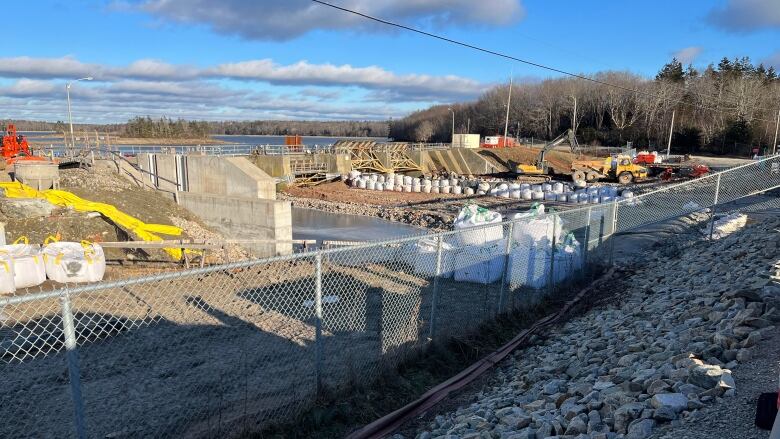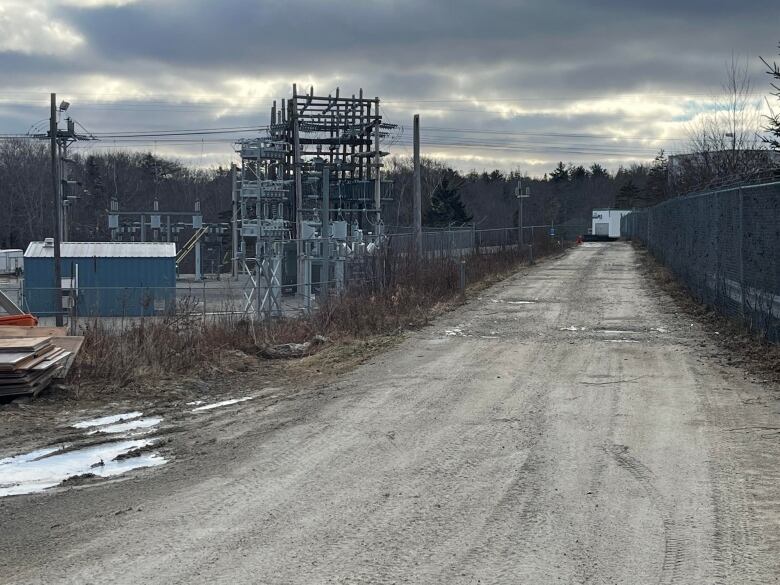NSP suspends plan to charge ratepayers $18M for dam cost overruns
Water migration persists at the construction site near Yarmouth

Nova Scotia Power has suspended its application to charge ratepayers $18 million for cost overruns on an ill-fated hydro dam as water migration at the construction site persists.
The utility said it is not clear yet what impact continued water infiltration will have on the replacement of the small dam at Tusket near Yarmouth.
Unexpected water seepage has already doubled the cost to $36 million and pushed the project three years behind schedule.
The most recent timeline has work completed in February 2023 a delay of 40 monthsfrom what was originally forecasted.
Nova Scotia Power thought it solved the problem. It spent $2 million on a core wall to prevent infiltration,andin 2021, it lowered the head pond above the dam to provide a dry construction site.
Last month, the company disclosed to regulators that even with the head pond lowered, water continues to filter into the construction zone.

"We continue to evaluate what, if any, impact the ongoing water migration issue might have in terms of both cost and project schedule," Nova Scotia Power spokesperson Jacqueline Foster told CBCNews in an email statement Tuesday.
Foster said the utility would be providing the provincial regulatorwith a status update by Jan. 31.
Nova Scotia Power said environmental permits stipulate the refurbishment cannot proceed until water is no longer infiltrating the construction zone.
Authorization to overspend
In July 2021, Nova Scotia Power was confident enough to apply to regulators for permission to charge ratepayers the $18 million it had spent above the amount approved by the Nova Scotia Utility and Review Board.
After alerting regulators to the continued water migration issue, Nova Scotia Power was allowed to suspend its application for authorization to overspend,also known as ATO,while it investigated.
In mid-December, the company said it would take about eight weeks to determine "whether there will be any material impacts on the amount of its ATO request."

"Nova Scotia Power is confident that it is making progress in dewatering the construction site, but more time is required to confirm that the company's current approach will maintain a dewatered construction site," Nova Scotia Power lawyer Matthew Gorman wrote the board on Dec. 14.
Prior to last month's disclosure, consultants hired by the Nova Scotia Utility and Review Board said Nova Scotia Power should have seen this coming since engineers recommended geotechnical investigation before construction began.
In evidence it filed with the board, Midgard Consulting rejected Nova Scotia Power's claim that "water infiltration issues could not have reasonably been foreseen."

"There is ample evidence that Nova Scotia Power was advised that geotechnical investigation was warranted," engineers for Midgard Consulting wrote.
"The evidence provided by Nova Scotia Power seems to indicate that it did not undertake any such geotechnical investigation. This is contrary to the advice of two separate engineers (AMEC in 2012 and Meco in 2014) and good engineering practice when designing structures in and around water impoundment structures."
Midgard said the company should have paused once the magnitude of the water infiltration problems was understood.
"Instead, Nova Scotia Power inflexibly continued pursuing execution of its preferred project configuration without re-evaluating alternatives, despite the resulting rate of (relatively ineffective) construction cost burn, and the parallel need for ongoing costly ad hoc scope additions."
Midgard saidNova Scotia Power knew very quickly that water infiltration made the $772,000 or five per cent set aside as a contingency woefully inadequate.
"Four months after making the original application, Nova Scotia Power understood that $630,000 of its contingency amount would be consumed by the embankment water infiltration issue (representing 82 per cent of the total contingency)."
Advocates call for overspending cap
The consultant for the consumer advocate,representing 400,000 residential customers, said the board should disallow $6.4 million in overspending.
"A cost overrun of more than 100 per cent on a project that was budgeted with a five per cent contingency factor is statistically improbable for a project that is properly planned, budgeted and executed," John Wilson wrote the board in November.
In its application, Nova Scotia Power said there was no indication during its regular operations or semi-annual dam inspections that there was water migration occurring under the main dam or through a nearby embankment dam.
"As such, Nova Scotia Power implemented a geotechnical investigation during the design process for the refurbishment of an existing dam, limiting the scope to a few boreholes to assess bedrock depth where the dam could be expanded. Identification and assessment of the water infiltration issues could only have occurred through construction activities."
The Tusket hydro system produces a tiny amount of electricity just 2.7 megawatts that is not much more than a single wind turbine.
Refurbishing, replacing better option for ratepayers
Nova Scotia Power said even with the "significant" cost overruns, refurbishing and replacing structures to comply with Canadian Dam Association standards is a better option for ratepayers than a partial decommissioning, which it estimates at $92 million.
The overruns include $3.5 million on water infiltration, $5.4 million on extended construction, $2 million securing additional permits and $1.4 million on archeology and Mi'kmaw consultation.
The latter was required when Nova Scotia Power was forced to lower the Lake Vaughan reservoir the dam's head pond potentially exposing Mi'kmawartifacts.












_(720p).jpg)


 OFFICIAL HD MUSIC VIDEO.jpg)
.jpg)



























































































